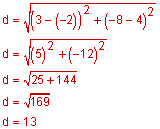 Section Warm-Up
Section Warm-Up
In this section, we are going to study three specific types of parallelograms. Before we do that, let’s review the properties we already know about parallelograms.
 Think & Click: Section Warm-Up
Think & Click: Section Warm-Up
Now, you try. Complete the Think & Click activity by looking at the problem below, thinking about it, and then clicking on the question to reveal the solution.
Using parallelogram ABCD shown below, answer the following questions.

If AB measures 2x + 7 and DC measures 5x – 14, what is the value of x?
AB = DC
2x + 7 = 5x – 14
21 = 3x
x = 7
If DM measures 5a + 4 and DB measures 108, what is the value of a?

5a + 4 = 54
5a = 50
a = 10
x = 37
If the perimeter of the parallelogram is 100 feet, AB measures 2b + 5 and AD measures b + 3, what is the value of b?
2(b + 5) + 2(b + 3) = 100
4b + 10 + 2b + 6 = 100
6b + 16 = 100
6b = 84
b = 14
If the area of the parallelogram is 100 square feet, DC measures20 and the height is p – 2, what is the value of p?
b∙h = A
20(p – 2) = 100
20p – 40 = 100
20p = 140
p = 7
If angle DAB measures 122° and angle BCD measures (12x + 14)°, find the value of x.
12x + 14 = 122
12x = 108
x = 9
Find the distance between (-2, 4) and (3, -8).

Find the slope of the line containing the points (3, 4) and (5, -4).

If a line has a slope of  , what is the slope of a line parallel to it? What is the slope of a line perpendicular to it?
, what is the slope of a line parallel to it? What is the slope of a line perpendicular to it?
 , what is the slope of a line parallel to it? What is the slope of a line perpendicular to it?
, what is the slope of a line parallel to it? What is the slope of a line perpendicular to it?Parallel lines have the same slope. m = 
Perpendicular lines have negative reciprocal slopes. m = ![]()
